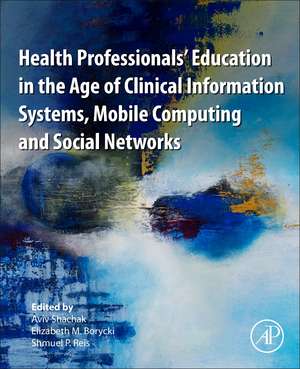Health Professionals' Education in the Age of Clinical Information Systems, Mobile Computing and Social Networks
Editat de Aviv Shachak, Elizabeth Borycki, Shmuel P. Reisen Limba Engleză Paperback – 27 iul 2017
Written by leading researchers from different parts of the world, the book is a valuable source for educators and professionals who are active or wish to be part of the health informatics field.
- Brings an in-depth understanding and background on the challenges for education of the health professions brought by information and communication technology
- Provides real-life examples on how technology is used in healthcare and how it can be used in education
- Presents valuable information in a visually appealing format with tables and figures
Preț: 496.74 lei
Preț vechi: 655.60 lei
-24% Nou
Puncte Express: 745
Preț estimativ în valută:
95.05€ • 99.24$ • 78.67£
95.05€ • 99.24$ • 78.67£
Carte tipărită la comandă
Livrare economică 28 martie-11 aprilie
Preluare comenzi: 021 569.72.76
Specificații
ISBN-13: 9780128053621
ISBN-10: 0128053623
Pagini: 530
Dimensiuni: 191 x 235 x 50 mm
Greutate: 1.07 kg
Editura: ELSEVIER SCIENCE
ISBN-10: 0128053623
Pagini: 530
Dimensiuni: 191 x 235 x 50 mm
Greutate: 1.07 kg
Editura: ELSEVIER SCIENCE
Public țintă
medical/nursing/health informatics educators; health care professionals; ICT developers.Cuprins
Part 1: The changing landscape of information and communication technology (ICT) in health care: implications for health professionals’ education1. Challenges in using clinical information systems2. Patient safety and quality assurance thrusts in digital healthcare and their influence on clinicians and patients3. The changing nature of the patient-clinician relationships4. Patients’ use of ICT and its implications5. Drowning in (big) data: self-tracking and the quantified self movement6. Vison(s) for health professions education of the 21st Century
Part 2: Experiences from the field7. Medical and other health professions’ schools for the 21st century8. Training clinicians in informatics
Part 3: Evidence from research9. Barriers to accessing technology for teaching clinical students, residents, and practitioners in and out of academia10. Academic educator competencies in teaching exam room computing and informatics11. Knowledge and attitudes of learners and teachers about aspects of healthcare in the digital world12. Influence of interventions on presence and behaviour of learners and practitioners in social media13. Digital natives and tourists in health IT14. Integration of clinical and educational interventions: How when and where?15. How to evaluate educational interventions to prepare health professionals for the challenges of the information age? (methodological focus)What have we learned? Findings from evaluation studies
Summary and Future Research Directions
Part 2: Experiences from the field7. Medical and other health professions’ schools for the 21st century8. Training clinicians in informatics
Part 3: Evidence from research9. Barriers to accessing technology for teaching clinical students, residents, and practitioners in and out of academia10. Academic educator competencies in teaching exam room computing and informatics11. Knowledge and attitudes of learners and teachers about aspects of healthcare in the digital world12. Influence of interventions on presence and behaviour of learners and practitioners in social media13. Digital natives and tourists in health IT14. Integration of clinical and educational interventions: How when and where?15. How to evaluate educational interventions to prepare health professionals for the challenges of the information age? (methodological focus)What have we learned? Findings from evaluation studies
Summary and Future Research Directions
